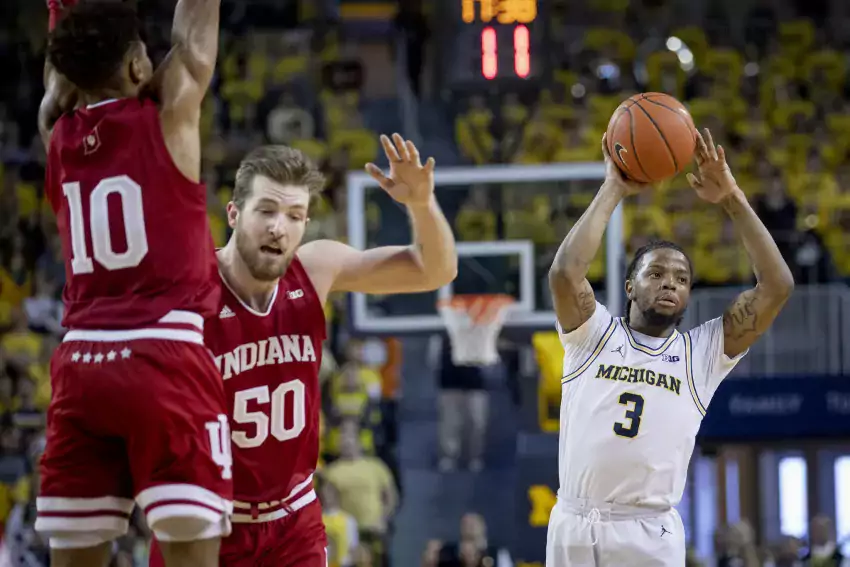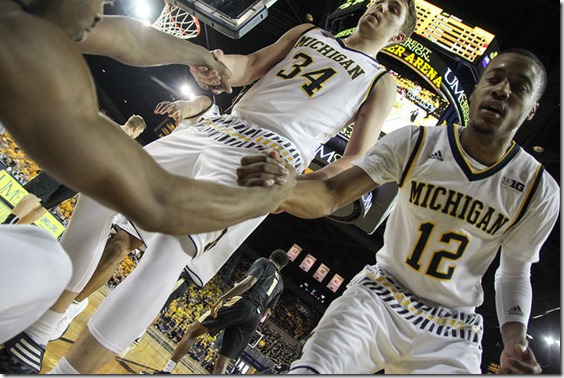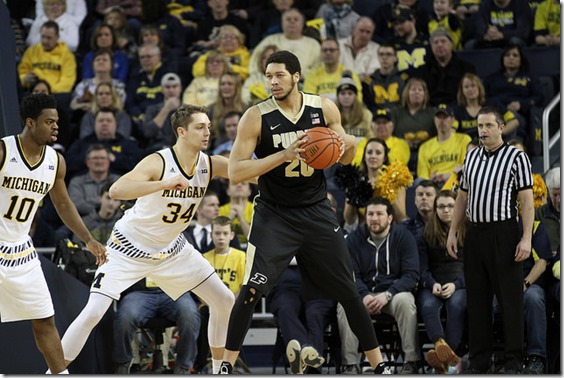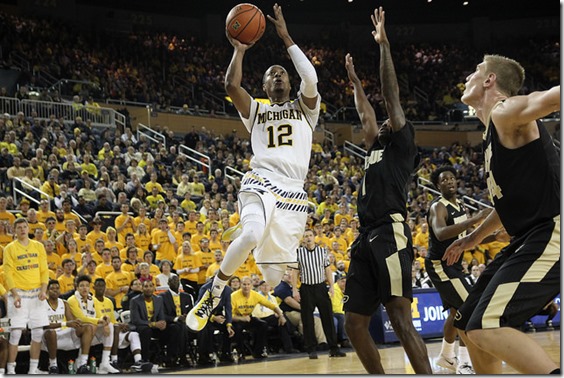post offense is inefficient

The Defensive Turnaround: Real or Opponent-Driven?
After Brian posted this in the Rutgers game column...
Teske back? Myles Johnson isn't exactly Luka Garza but he is shooting 53% from the floor on decent usage in Big Ten play. Teske shut him off. Johnson was 0/3 and all three of his shots might have been blocked by Teske. Indiana's Trayce Jackson-Davis had as many points (4) in the first three minutes of the Indiana-Minnesota game as he had against Michigan, when he was 2/3 from the floor. IIRC not much of De'ron Davis's game came against Teske.
Tillman did okay personally from two (6/10) but MSU collectively shot 38% from two; OSU shot 44% and Wesson's twos were mostly putbacks or fadeaway jumpers.
Teske's been very rough offensively for the last month but as Michigan's defense surges he seems to be a major part of that. A return game against Trevion Williams up next will be a good measuring stick.
...I took a look at Synergy to see if there were some explanation for Michigan's defensive improvement beyond Teske simply playing better. This led to an entire post's worth of information.
The stats that leap off Michigan's defensive page are their wildly varying abilities against certain sets. They boast a remarkably good pick-and-roll defense but are among the worst power conference programs against isolations and post-ups. Here are the numbers from Synergy for M's defense, with passes included (note: Synergy separates out putbacks from offensive rebounds, so the points per possession figures are lower than you might anticipate):
| % Time | Points Per Possession | Percentile Rank | eFG% | TO% | |
|---|---|---|---|---|---|
| Pick and Rolls | 33.5 | 0.724 | 95 | 39.7 | 12.8 |
| Post-Ups | 10.8 | 0.951 | 17 | 48.3 | 8.1 |
| Isolations | 7.1 | 0.918 | 13 | 48.7 | 9.6 |
The good news: pick-and-rolls are generally better offense than post-ups and isos, so if you have to choose a play to be killer at defending, that's the right one.
After that, I wanted a good visual of Big Ten offenses and their acumen in pick-and-roll and post-up situations. I'm dire at working with anything related to Excel, so thankfully Seth put together some scatter plots for me. My (rather obvious) operating hypothesis was that Michigan would prefer to avoid good post-up teams. Here are the Big Ten's post offenses charted by frequency and efficiency:
_6.png)
Michigan's worst defensive performances have come against these teams almost without exception—the outlier is the first Michigan State game, when the Wolverines couldn't slow down the Winston/Tillman pick-and-roll. Iowa, led by Luka Garza, broke the original scale—Garza is so obscenely good in the paint that the Hawkeyes are more efficient on post-ups than any Big Ten team is on pick-and-rolls. Purdue will, indeed be a big test.
The Wolverines haven't had many of those lately. Indiana is their worst defensive performance by adjusted efficiency since the Jan. 17th loss at Carver-Hawkeye. Their next-worst game in that span: Illinois. Other than Ohio State, which the defense handled relatively well despite the loss, Michigan's recent stretch of good defense has come against teams that generally don't post up often or particularly well—Rutgers checks both boxes.
I'm worried a decent portion of Michigan's recent defensive turnaround is due to the competition. The stretch run will be a challenge. The next three games all come against post-oriented teams: Purdue, Wisconsin, and Ohio State. Then comes a respite against Nebraska before closing the season against Maryland, a very good team but one that Michigan is well-suited to defense.
[Hit THE JUMP for why that's the case, plus a look at the conference's defenses and a preview of Sunday's M/MSU WBB tilt.]
pick me up [Eric Upchurch]
So that was odd. For some reason during this game I thought to myself that this team was a stereotype of Beilein teams, a stereotype of the variety that gets passed around message boards that always, always call Michigan "scUM."
It more or less is. Michigan is 146th in defensive efficiency even after a strong outing against Purdue. They're 12th in the league in two point defense. They don't get to the line and don't get to the offensive boards. All of these things are more or less true every year. They're less easy to stomach when you get hammered over and over by teams that can exploit Michigan's various and sundry flaws. Michigan's been blown out of the building in every loss save Iowa*, often because they've resembled a grim parody of John Beilein basketball.
So I am thinking this and then Michigan wins a game by holding Purdue to 56 points. Michigan is 5/20 from three and significantly outrebounds a gigantic Purdue outfit. Okay. Whatever. In this very stereotypical Beilein year this was a genre-defying game.
*[That game was reasonably competitive despite the 11-point final margin.]
Doubly odd. Meanwhile there was a period in the second half when Michigan's offense devolved into ridiculous heroball. Walton, Irvin, and Robinson all took very bad shots on which they tried to beat guys off the dribble, failed, and shot anyway. This was during a 2/20 run from the floor. It was deeply unpleasant, and then Michigan won anyway.
Walton ain't wiltin'. Takes some cojones to drive in the vicinity of Hammons when you're 0/9 for the game and then aim for contact, but Derrick Walton has always been an assassin at the end of games. As a freshman he closed out wins against MSU and Nebraska with and-one drives; here he pushed Michigan in front on their 11-0 closing spurt. He then made four free throws down the stretch to seal it. I'm not a big fan of "clutch" but in his case I'll allow it.
While we're talking about weird-ass Derrick Walton, should be noted that he's still the top defensive rebouder on the team, and that is a good sign, not an ominous one. Michigan always does this thing where their defensive rebounding looks pretty good through the nonconference season and then they finish 10th or so in the league; not so this year. Michigan is 3rd(!) in the league at defensive rebounding. They haven't managed that since 2009, when Anthony Wright was tossing bombs at Oklahoma in the second round of the tourney instead of at Dan Dakich on Twitter.
Walton appears to have a tangible positive effect on Michigan's team rebounding, which is huge for a team that plays as small as Michigan does. A 6-foot-nothing point guard led all rebounders in a game featuring Purdue with 7 DREBs. Again, Purdue versus Derrick Walton and Walton wins.
Ticket more or less punched. Michigan needed to find a couple wins in a difficult closing stretch to feel secure about a bid; with the Purdue win they have reached 19 wins against a difficult schedule (SMU, Texas, UConn, and Xavier are all top-25 Kenpom teams). They've got three wins that will go on everyone's "good" list and zero bad losses. One of those wins is against a projected one-seed. Even if they had a season-ending skid that is not a profile that gets left out, especially when two programs that would normally be in the tournament (SMU and Lousiville) are taking postseason bans this year. And that's before the committee accounts for the fact that Levert has barely played during the Big Ten schedule.
Michigan would likely have to lose out to be on the bubble.
[Eric Upchurch]
This is what I am saying about post offense. It's inefficient. Purdue makes it work better than most because they have simply enormous dudes but as Ace pointed out, all those post ups lead to a barrage of two point jumpers that aren't good at scoring points. This game was a good example of why. Hammons got shut out(!!!) on the offensive boards and Haas got just one. Those two combined to go 9/21 from the field and 3/7 from the line, with two of the makes Hammons 15-footers. Hammons turned it over 3 times. All this was against a very bad defense.
Hammons is 88% at the rim but:
- 71% of his shots there are assisted
- another 18% are putbacks, so
- 11% of his shots at the rim are unassisted non-rebouds, ie, post-ups.
Meanwhile he's hitting 39% on two point jumpers, which comprise the vast majority of shots arising from post ups. Haas is similar but is hitting 48%. And both guys see a lot of assists on their two point makes, which means raw put-it-on-the deck post ups are mostly a waste of time even when you have the biggest damn team in the world against a bad defense.
I am completely fine with the way Michigan has discarded post-ups entirely. I just wish they'd recruit posts based solely on resemblance to Dikembe Mutumbo; all the guy has to do is dunk and wag his finger.
(Other possibility: Purdue is super generous with assists. They're 11th nationally in A/FGM, and I've seen them play. That's not reality.)
Robinson quiet, but occupying people. Purdue has Raphael Davis. Davis is the reigning Big Ten Defensive Player of the Year. Raphael Davis spent most of this game checking Duncan Robinson. This resulted in Robinson not doing much and an ugly offensive game for the rest of the team, but Irvin got loose in part because he got a matchup against Swanigan; only after he'd heated up did Purdue try to match Davis on him.
If Levert does get back to full strength either he occupies the ace defender and Robinson gets loose or he gets to attack those wide open lanes. This is one of two reasons getting LeVert back and functional is so critical; the other is that the committee won't give Michigan the benefit of the doubt for his absence unless he does return.
[Upchurch]
MAAR, ball-hawk. Abdur-Rahkman helped rescue the game with a couple of key steals late. That's a flash of the perimeter defender we hoped we were getting last year after he shut down DeAngelo Russell; for a lot of reasons that has not really manifested itself. He's probably been Michigan's most consistent defender, but that's not saying much.
While he's not exactly a standout statistically, he's piecing it together this year. He's shooting really well in conference (76%/59%/41%), he's inching up that assist rate, and he's getting to the line. Usage is still in the Spike Albrecht range; that's the main hangup when you're trying to project him. He should be a very solid upperclassman; the ten-point bump in his three point shooting percentage is encouraging.
Okay Caris. Just get right by the Big Ten Tournament. Now that he's seen the court the direst predictions are off the table.



10